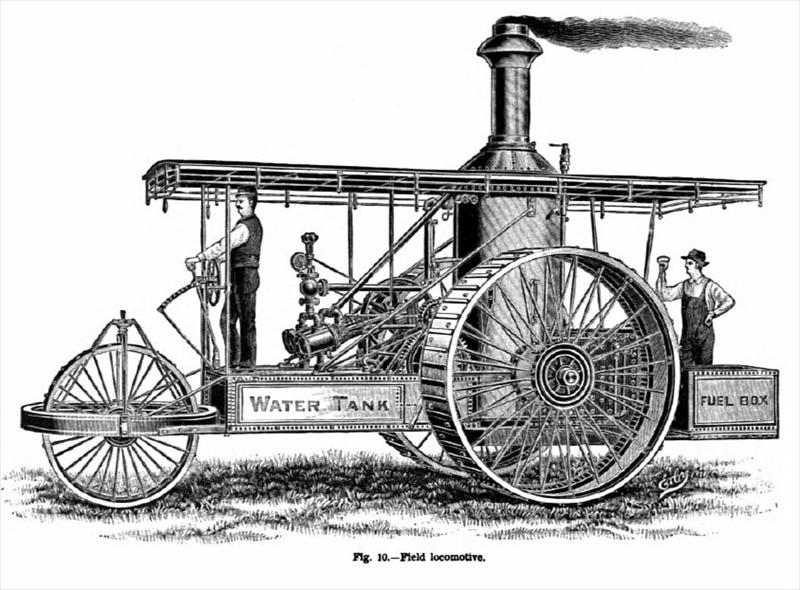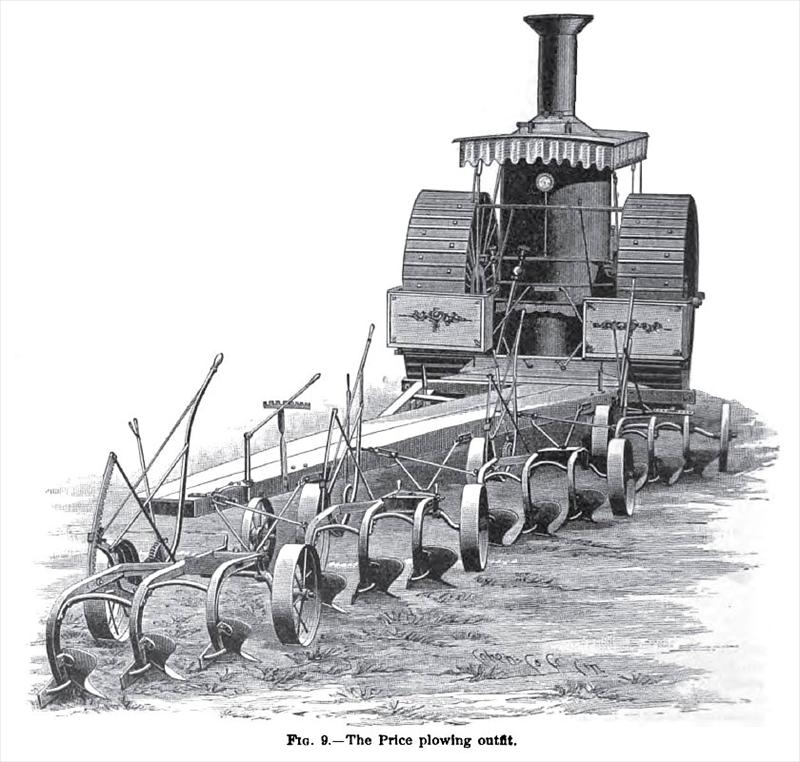|
Title: |
1895 Article-Jacob Price, Steam Field Locomotive |
|
Source: |
Modern Mechanism 1895 pgs 638-640 |
|
Insert Date: |
12/6/2011 11:56:28 AM |
Steam-plows — The system of drawing gangs of plows with a suitable traction steam engine is favored in the United States and known as "the American System," to distinguish it from "the English System" of drawing the gangs of plows back and forth across the field with long cables wound on drums revolved by stationary steam-engines. This
preference in the United States may be ascribed mainly to the greater length of furrow and more level character of the land in the regions of large farming operations, where steam plowing is in course of introduction on the prairies of the great Mississippi basin, the great plateaus of the Northwest, and the wide, flat valleys of the Pacific coast country.
Fig. 9 shows the Jacob Price plowing outfit, his plowing engine drawing four gangs of three plows each at the California State Fair of 1890 made by J. I. Case, of Racine, Wis.; weight of engine, 8½ tons, the twelve plows cutting 11 ft. wide. The four gangs are independently attached to a strong, light platform running on casters, and the lifting lever of each gang is so arranged that the fireman can handle it from the run-board of the platform without descending to the ground, while going. The platform is hooked to the engine at only one point, and the whole rig is designed for lightness and strength, distributing the strains. In this class of steam-plowing the running speed is from 2½ to 4½ miles an hour, according to the character of the soil and the number of plows drawn. The bearing surfaces of the three engine wheels are extraordinarily broad in proportion to the weight of the engine, and pre vent sinking into the face of the ground even on soft land. On ordinary soft prairie or pasture land they leave but a faint impression. The two driving-wheels are 8 ft. high, with 26 in. of face. Large, wide wheels allow the use of numerous grouters or lugs of moderate projection, an advantage when the ground is hard and impenetrable, instead of the few hut very prominent grouters requisite on the smaller traction wheels of farm engines of ordinary type. To lighten the engine, a high-pressure boiler with thick walls is used under heavy steam pressure, increasing power relatively to weight of engine and boiler as a whole, and yielding a large power available for draft in excess of the power consumed by the engine in profiling itself. Fig. 10 is a side view of the latest model of the Jacob Price field locomotive, specially designed for plowing, though available for other mobile or stationary work. It is estimated at 70 horse power. It performs the duty of forty actual horses in pulling, besides its selfpropulsion. Driving-wheels 8 ft. x28 in.; steering-wheel 5ft. x l4in.; capacity of water-tank 500 gallons; of fuel-boxes l,500 lbs. of coal. The boiler is a combination of the upright and horizontal types, with a working pressure of 150 lbs. per sq. in., driving twin engines having piston valves. It consumes about 250 lbs. of coal per hour. Wood may be used for fuel if desired. It has two speeds, the plowing speed of about 3 miles, and travelling speed of 5 miles per hour. |
|
 1895 Jacob Price, Steam Field Locomotive
1895 Jacob Price, Steam Field Locomotive
 1895 Jacob Price, Steam Plowing Outfit
1895 Jacob Price, Steam Plowing Outfit
|
|